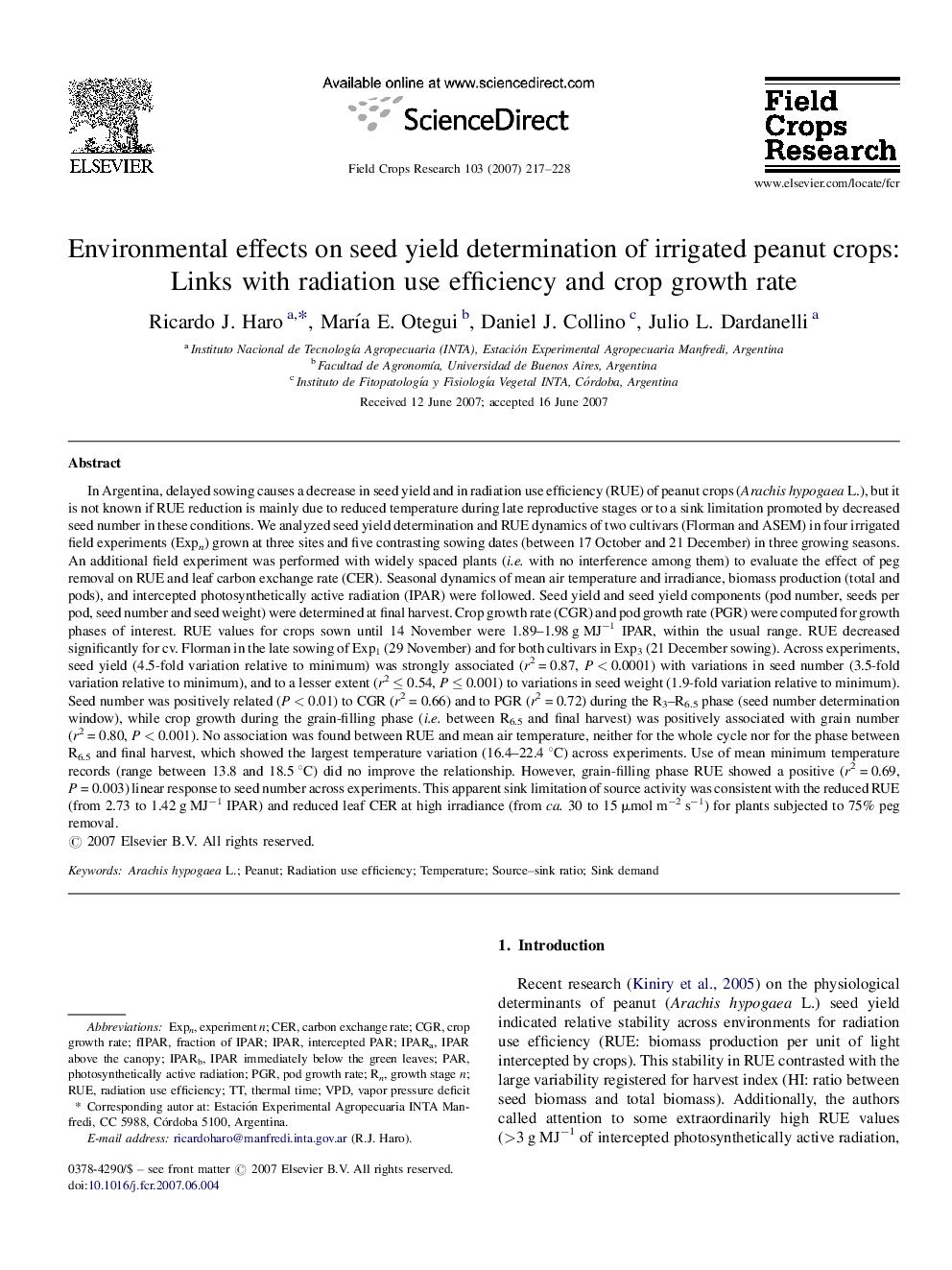| کد مقاله | کد نشریه | سال انتشار | مقاله انگلیسی | نسخه تمام متن |
|---|---|---|---|---|
| 4511588 | 1321921 | 2007 | 12 صفحه PDF | دانلود رایگان |
عنوان انگلیسی مقاله ISI
Environmental effects on seed yield determination of irrigated peanut crops: Links with radiation use efficiency and crop growth rate
دانلود مقاله + سفارش ترجمه
دانلود مقاله ISI انگلیسی
رایگان برای ایرانیان
کلمات کلیدی
موضوعات مرتبط
علوم زیستی و بیوفناوری
علوم کشاورزی و بیولوژیک
علوم زراعت و اصلاح نباتات
پیش نمایش صفحه اول مقاله

چکیده انگلیسی
In Argentina, delayed sowing causes a decrease in seed yield and in radiation use efficiency (RUE) of peanut crops (Arachis hypogaea L.), but it is not known if RUE reduction is mainly due to reduced temperature during late reproductive stages or to a sink limitation promoted by decreased seed number in these conditions. We analyzed seed yield determination and RUE dynamics of two cultivars (Florman and ASEM) in four irrigated field experiments (Expn) grown at three sites and five contrasting sowing dates (between 17 October and 21 December) in three growing seasons. An additional field experiment was performed with widely spaced plants (i.e. with no interference among them) to evaluate the effect of peg removal on RUE and leaf carbon exchange rate (CER). Seasonal dynamics of mean air temperature and irradiance, biomass production (total and pods), and intercepted photosynthetically active radiation (IPAR) were followed. Seed yield and seed yield components (pod number, seeds per pod, seed number and seed weight) were determined at final harvest. Crop growth rate (CGR) and pod growth rate (PGR) were computed for growth phases of interest. RUE values for crops sown until 14 November were 1.89-1.98 g MJâ1 IPAR, within the usual range. RUE decreased significantly for cv. Florman in the late sowing of Exp1 (29 November) and for both cultivars in Exp3 (21 December sowing). Across experiments, seed yield (4.5-fold variation relative to minimum) was strongly associated (r2 = 0.87, P < 0.0001) with variations in seed number (3.5-fold variation relative to minimum), and to a lesser extent (r2 â¤Â 0.54, P â¤Â 0.001) to variations in seed weight (1.9-fold variation relative to minimum). Seed number was positively related (P < 0.01) to CGR (r2 = 0.66) and to PGR (r2 = 0.72) during the R3-R6.5 phase (seed number determination window), while crop growth during the grain-filling phase (i.e. between R6.5 and final harvest) was positively associated with grain number (r2 = 0.80, P < 0.001). No association was found between RUE and mean air temperature, neither for the whole cycle nor for the phase between R6.5 and final harvest, which showed the largest temperature variation (16.4-22.4 °C) across experiments. Use of mean minimum temperature records (range between 13.8 and 18.5 °C) did no improve the relationship. However, grain-filling phase RUE showed a positive (r2 = 0.69, P = 0.003) linear response to seed number across experiments. This apparent sink limitation of source activity was consistent with the reduced RUE (from 2.73 to 1.42 g MJâ1 IPAR) and reduced leaf CER at high irradiance (from ca. 30 to 15 μmol mâ2 sâ1) for plants subjected to 75% peg removal.
ناشر
Database: Elsevier - ScienceDirect (ساینس دایرکت)
Journal: Field Crops Research - Volume 103, Issue 3, 13 September 2007, Pages 217-228
Journal: Field Crops Research - Volume 103, Issue 3, 13 September 2007, Pages 217-228
نویسندگان
Ricardo J. Haro, MarÃa E. Otegui, Daniel J. Collino, Julio L. Dardanelli,